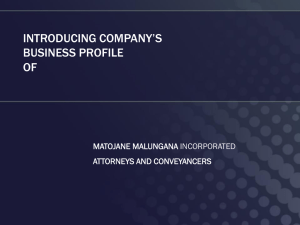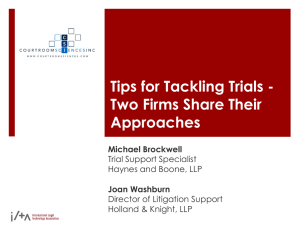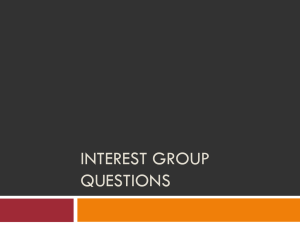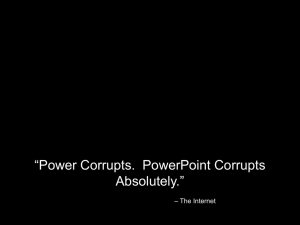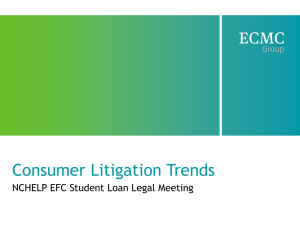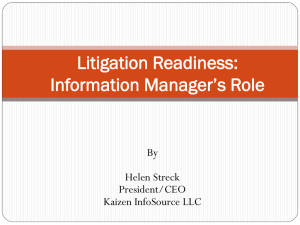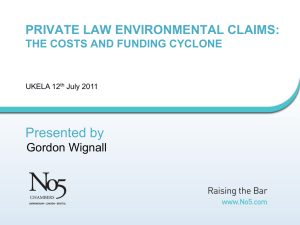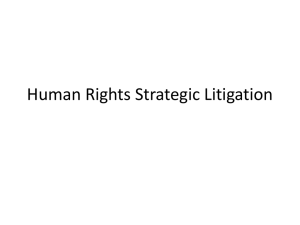Soaring costs of civil litigation, lengthy trials, and the fact that most
advertisement
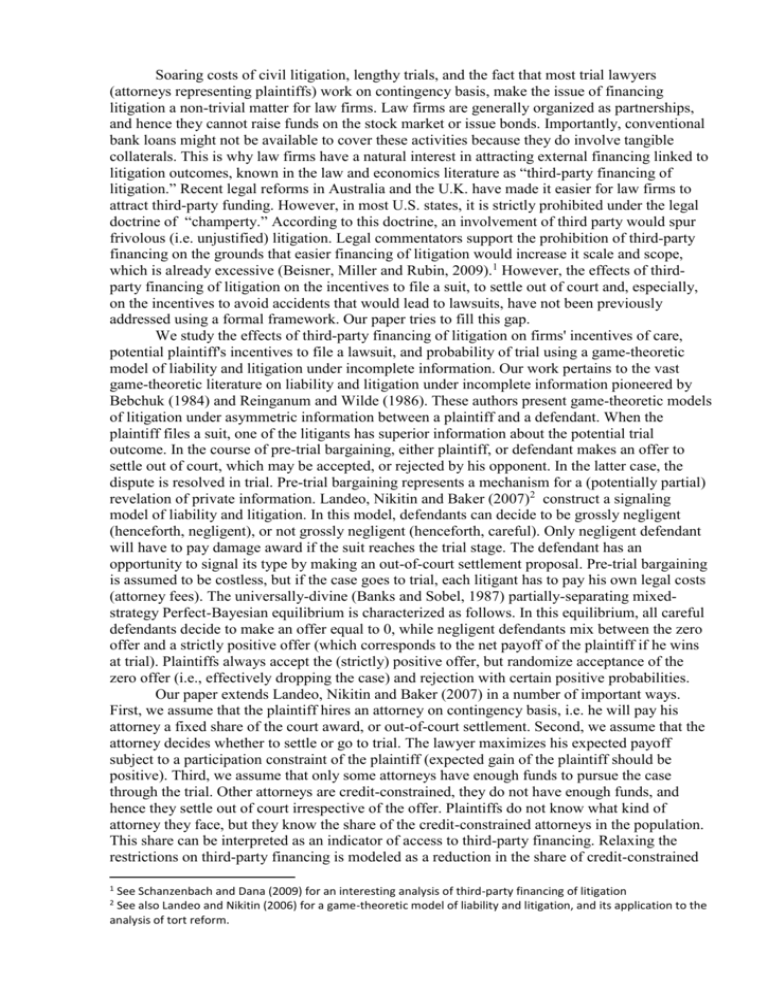
Soaring costs of civil litigation, lengthy trials, and the fact that most trial lawyers (attorneys representing plaintiffs) work on contingency basis, make the issue of financing litigation a non-trivial matter for law firms. Law firms are generally organized as partnerships, and hence they cannot raise funds on the stock market or issue bonds. Importantly, conventional bank loans might not be available to cover these activities because they do involve tangible collaterals. This is why law firms have a natural interest in attracting external financing linked to litigation outcomes, known in the law and economics literature as “third-party financing of litigation.” Recent legal reforms in Australia and the U.K. have made it easier for law firms to attract third-party funding. However, in most U.S. states, it is strictly prohibited under the legal doctrine of “champerty.” According to this doctrine, an involvement of third party would spur frivolous (i.e. unjustified) litigation. Legal commentators support the prohibition of third-party financing on the grounds that easier financing of litigation would increase it scale and scope, which is already excessive (Beisner, Miller and Rubin, 2009).1 However, the effects of thirdparty financing of litigation on the incentives to file a suit, to settle out of court and, especially, on the incentives to avoid accidents that would lead to lawsuits, have not been previously addressed using a formal framework. Our paper tries to fill this gap. We study the effects of third-party financing of litigation on firms' incentives of care, potential plaintiff's incentives to file a lawsuit, and probability of trial using a game-theoretic model of liability and litigation under incomplete information. Our work pertains to the vast game-theoretic literature on liability and litigation under incomplete information pioneered by Bebchuk (1984) and Reinganum and Wilde (1986). These authors present game-theoretic models of litigation under asymmetric information between a plaintiff and a defendant. When the plaintiff files a suit, one of the litigants has superior information about the potential trial outcome. In the course of pre-trial bargaining, either plaintiff, or defendant makes an offer to settle out of court, which may be accepted, or rejected by his opponent. In the latter case, the dispute is resolved in trial. Pre-trial bargaining represents a mechanism for a (potentially partial) revelation of private information. Landeo, Nikitin and Baker (2007)2 construct a signaling model of liability and litigation. In this model, defendants can decide to be grossly negligent (henceforth, negligent), or not grossly negligent (henceforth, careful). Only negligent defendant will have to pay damage award if the suit reaches the trial stage. The defendant has an opportunity to signal its type by making an out-of-court settlement proposal. Pre-trial bargaining is assumed to be costless, but if the case goes to trial, each litigant has to pay his own legal costs (attorney fees). The universally-divine (Banks and Sobel, 1987) partially-separating mixedstrategy Perfect-Bayesian equilibrium is characterized as follows. In this equilibrium, all careful defendants decide to make an offer equal to 0, while negligent defendants mix between the zero offer and a strictly positive offer (which corresponds to the net payoff of the plaintiff if he wins at trial). Plaintiffs always accept the (strictly) positive offer, but randomize acceptance of the zero offer (i.e., effectively dropping the case) and rejection with certain positive probabilities. Our paper extends Landeo, Nikitin and Baker (2007) in a number of important ways. First, we assume that the plaintiff hires an attorney on contingency basis, i.e. he will pay his attorney a fixed share of the court award, or out-of-court settlement. Second, we assume that the attorney decides whether to settle or go to trial. The lawyer maximizes his expected payoff subject to a participation constraint of the plaintiff (expected gain of the plaintiff should be positive). Third, we assume that only some attorneys have enough funds to pursue the case through the trial. Other attorneys are credit-constrained, they do not have enough funds, and hence they settle out of court irrespective of the offer. Plaintiffs do not know what kind of attorney they face, but they know the share of the credit-constrained attorneys in the population. This share can be interpreted as an indicator of access to third-party financing. Relaxing the restrictions on third-party financing is modeled as a reduction in the share of credit-constrained 1 See Schanzenbach and Dana (2009) for an interesting analysis of third-party financing of litigation See also Landeo and Nikitin (2006) for a game-theoretic model of liability and litigation, and its application to the analysis of tort reform. 2 attorneys. In contrast to general beliefs about the negative effect of third-party financing of litigation on the likelihood of trial, we find that the probability of trial (conditional on accident) is independent of the share of credit-constrained attorneys. Despite a direct positive effect of a reduction in the share of credit-constrained attorneys on the probability of trial (fewer attorneys are forced to settle because of the lack of funds), this effect is fully offset by a reduction in the equilibrium probability of rejecting the zero offer. In other words, there is a higher likelihood that attorneys will drop their cases, despite the availability of funds to go to trial. We then study the effects of third-party financing on litigation on firm's level of care by adding a preliminary stage to the game, where the potential defendant decides on the level of care, i.e. whether to be careful, or negligent. If the defendant is negligent, the probability of accident is higher than if he is careful. The potential plaintiff next decides whether to file a lawsuit. In this framework, the equilibrium level of care, the probability of filing a lawsuit and the (post-accident) probability that the defendant is negligent becomes endogenous. We find an equilibrium in which the potential defendant is indifferent between taking care or being negligent, while the representative attorney is indifferent between taking and turning down the case. We find that a higher share of unconstrained attorneys increase the conditional (on accident) expected litigation loss, but the higher loss increase the probability of care, which, in turn reduce equilibrium filing. Our results suggest that the consequences of access to third-party financing are not unambiguously negative. Indeed, under certain conditions, the prohibition of third-party financing of litigation might be welfare-reducing. Policy-makers should assess the prohibition of third-party financing of litigation with caution. _____________________________________________________________________________ Banks, J.S. and Sobel, J. (1987) “Equilibrium Selection in Signaling Games.” Econometrica 55, 647--661. Bebchuk, L.A. (1984). “Litigation and Settlement under Imperfect Information.” Rand Journal of Economics 15, 404-415. Biesner J., Miller, J. and Rubin, G. (2009). “Selling Lawsuits, Buying Trouble: Third-Party Litigation Funding in the United States.” Mimeo, U.S. Chamber Institute for Legal Reform. Landeo, C.M., Nikitin, M., and Baker, S. (2007). “Deterrence, Lawsuits and Litigation Outcomes under Court Errors.” Journal of Law, Economics, and Organization 23, 57-97. Landeo, C.M. and Nikitin, M. (2006). “Split-Award Tort Reform, Firms Level of Care and Litigation Outcomes.” Journal of Institutional and Theoretical Economics 162, 571-600. Reinganum, J.F. and Wilde, L.L. (1986). “Settlement, Litigation, and the Allocation of Litigation Costs.” RAND Journal of Economics 17, 557-566. Schanzenbach, M. and Dana, D. (2009). “How Would Third Party Financing Change the Face of American Tort Litigation? The Role of Agency Costs in the Attorney-Client Relationship.” Mimeo, Northwestern University School of Law.
